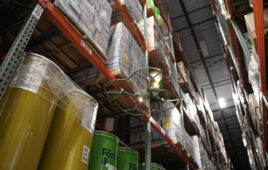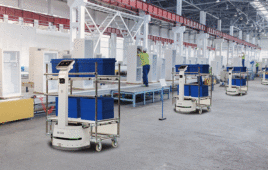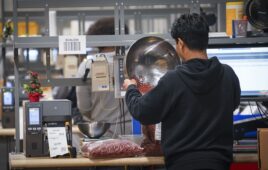The sudden pandemic-related labor shortage was an eye-opener that forced companies to rethink operations and plan for more changes. As employee populations shift toward “digital natives,” companies can leverage such workers’ tech skills to increase efficiency and throughput.
Before Siri or Alexa, there was Jennifer — a voice-directed technology that links humans and machines to orchestrate warehouse operations. She’s an AI workhorse that provides comfort and confidence in people-occupied facilities.
“Jennifer can manage several hundred workers simultaneously, constantly recalculating orders and line items,” said Ken Ramoutar, CMO at Lucas Systems. “She does all kinds of smart things that workers don’t see, but they feel the results. For example, a warehouse worker might walk six or eight miles daily. Jennifer helps them get the job done in half that distance.”
These days, automation technology such as AGVs and AMRs get the spotlight for solving labor issues, reducing costs, increasing throughput, and making operations more efficient. But there’s still a sizable number of warehouses depending solely on people.
“We’ve been around 25 years, and more than ever, warehouse workers have become recognized as a huge asset,” said Ramoutar.

Warehouse workers use headsets and wearables with voice-directed AI technology that synchronizes humans and machines. Image courtesy of Zebra.
COVID-19 taught the world the value of distribution center labor. To prepare the industry for another wave of change — with Generation Z entering the workforce — warehouses need to consider the role of technology in employee retention.
“It’s hard work. It’s stressful work. So, if you want to attract the younger workforce, you better have good tech that helps them, trains them, and gives them information — all things that group expects,” said Ramoutar.
Gen Z grew up with smartphones, tablets, and voice-directed watches. Digital interfaces are as intuitive to them as operating a kitchen faucet. They have quick learning curves for modern gadgets and devices that occupy their daily lives and expect workplaces to supply them with what they need to do their jobs.
But it’s not just Gen Zs. Across the board, employees expect operations to include technologies that make their jobs better and safer.
According to market study insights from Lucas Systems, people value technology so much that they are willing to take a pay cut and switch jobs to use tech that helps them work.
The study polled 500 U.S. on-floor warehouse workers in May 2022 to examine their relationships with technology and their fears, expectations, and perceptions about their daily jobs. Developed as the “Voice of the Warehouse Worker,” the study was conducted by Wakefield Research for Lucas Systems.
In the study, nearly 3 out of 4 (74%) on-floor workers said they would consider a pay cut at another company for an opportunity to use technology if it helps them in their job. Workers also said they are physically spent, spending over a third of their day walking, and would welcome tech’s help in the form of robots or other tech tools.
Other market study insights included:
- 75% of workers said physical strain in their jobs takes a larger toll on them than mental strain. The leading cause of physical strain is carrying or lifting, followed by walking or traveling.
- Top causes of mental strain include meeting performance or incentive goals and objectives (25%) and safely maneuvering around the warehouse (20%).
- Workers see robots as productive allies but fear increased quotas. More than two in five believe robots will reduce physical stress (46%) or help them achieve better speed in item picking (44%) or better accuracy (40%).
- In the study, workers perceived their company’s technology as an investment in them. Lucas Systems says this is meaningful in an industry already facing a labor shortage.
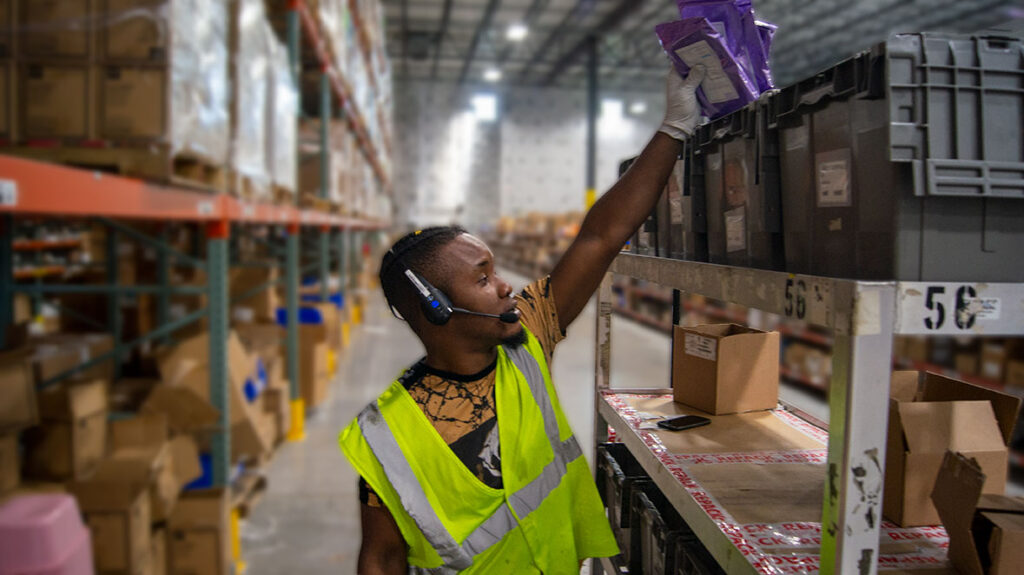
While warehouses compete for business, they also compete for a reliable workforce, and the next generation of workers expects modern tech to make their jobs easier. Image courtesy of Lucas Systems.
“We’re in 400 warehouses across the globe, and there aren’t too many robots in any of them. Many people are thinking about robots and might install a couple to see where they make sense. Then, they might add a few more. We believe this ecosystem of people and robots will be the end game,” said Ramoutar.
Warehouse leaders agree that helping humans and machines get along is critical for automation success. They also understand that AI-embedded technology is the link for efficient human-machine interactions, but many feel unsure of how to make AI work in their facilities.
According to another Lucas study released in 2021, executives are optimistic about AI — counting on quick and generous returns from their investment and expecting an average ROI of more than 60% within five years of implementation. Despite this optimism, 99% of organizations face challenges using AI effectively. The top reasons are:
- Perceptions of high costs compared to benefits
- Concerns about risks and control of operations decisions
- Cost and time for training and a lack of understanding of implementation
Nearly 90% of respondents, regardless of industry, admitted they need more expertise and information regarding implementation and use.
“There’s a belief that AI is a heavy lift — that it’s difficult to use and risky or expensive. This thinking prevents widespread adoption in the warehouse and the ability to tap AI’s true potential,” said Ramoutar.
Lucas believes the key to driving transformational impact in the warehouse is providing AI where users or IT staff don’t have to be experts to leverage AI-embedded technologies, such as voice, dynamic slotting, and in-warehouse travel optimization solutions.
For example, earlier this year, the company announced its rollout of new technologies promising productivity, comfort, and ease of use for the future Gen Z workforce.
The technologies — built to serve the new “iGeneration” of workers born between 1997 and 2012 — promise to reduce worker stress, provide a less physically-taxing work experience, and help on-floor supervisors be more agile. New technologies include:
- An all-new supervisor management console that provides leadership with a high degree of flexibility and agility to customize data, dashboards, and analytics specific to their operation and needs. Supervisors and managers can get actionable information in a way that’s easy to understand and use through fully customizable consoles.
- New algorithms and machine learning intelligence that reduce walking by up to 50% by showing workers optimal navigation paths.
- The ability for on-floor workers to use the smallest wearables for scanning. Lucas Systems certified its voice-enabled optimization suite, Jennifer, to run on a Zebra WS50, the world’s smallest all-in-one Android enterprise-class wearable mobile computer.
These insights were released in the company’s “Competing for the Warehouse Workforce of the Future” guide, which includes recommendations for attracting and retaining labor. One insight is that most Gen Z workers (73%) say robots will help them achieve greater accuracy and speed in their jobs.
“It’s a competition, and it’s not going to get better,” said Ramoutar. “Baby Boomers and Gen X don’t necessarily expect a super automated place. It’s the Gen Zs who are asking, ‘Where’s the good tech that I need to do my job?’ So, if a warehouse looks outdated and hasn’t been modernized, they won’t work there.”
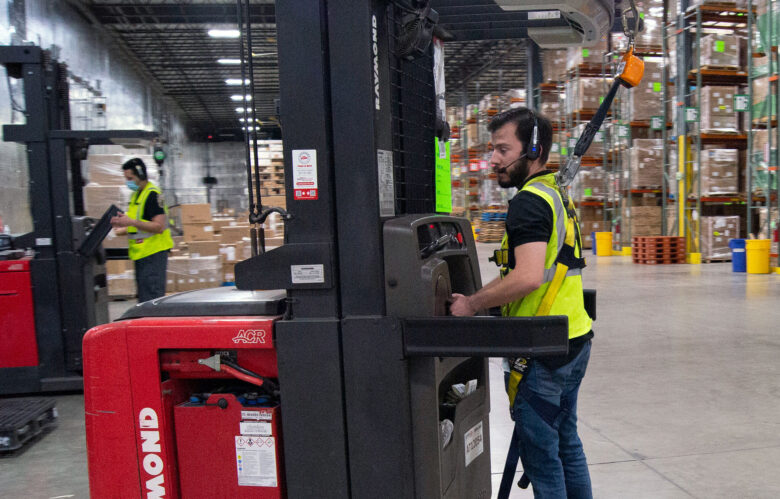
Jennifer has a natural human voice that workers can adjust, enabling diversity and inclusion in the warehouse. Image courtesy of Lucas Systems.
It’s clear that no matter how many robots are deployed worldwide, warehouses will still need people for quite some time. That means the industry will continue needing AI-embedded tech to synchronize operations for future hybrid — and diverse — workforces.
For instance, Jennifer understands and speaks 34 languages, removing communication barriers that make expansion, hiring, and training easier and faster. Workers can also adjust Jennifer so that she speaks slower or louder, accommodating a broader range of people.
“We have places in the U.S. where Jennifer works in multiple languages in the same warehouse. Individuals speaking Spanish work alongside others speaking Arabic. And the supervisors are probably speaking another language or English. They all can work better and faster with less stress without a common language,” said Ramoutar. “Having this tech for people matters.”
Lucas Systems
lucasware.com
Filed Under: NEWS • PROFILES • EDITORIALS, AI • machine learning, Warehouse automation, ENGINEERING SOFTWARE

